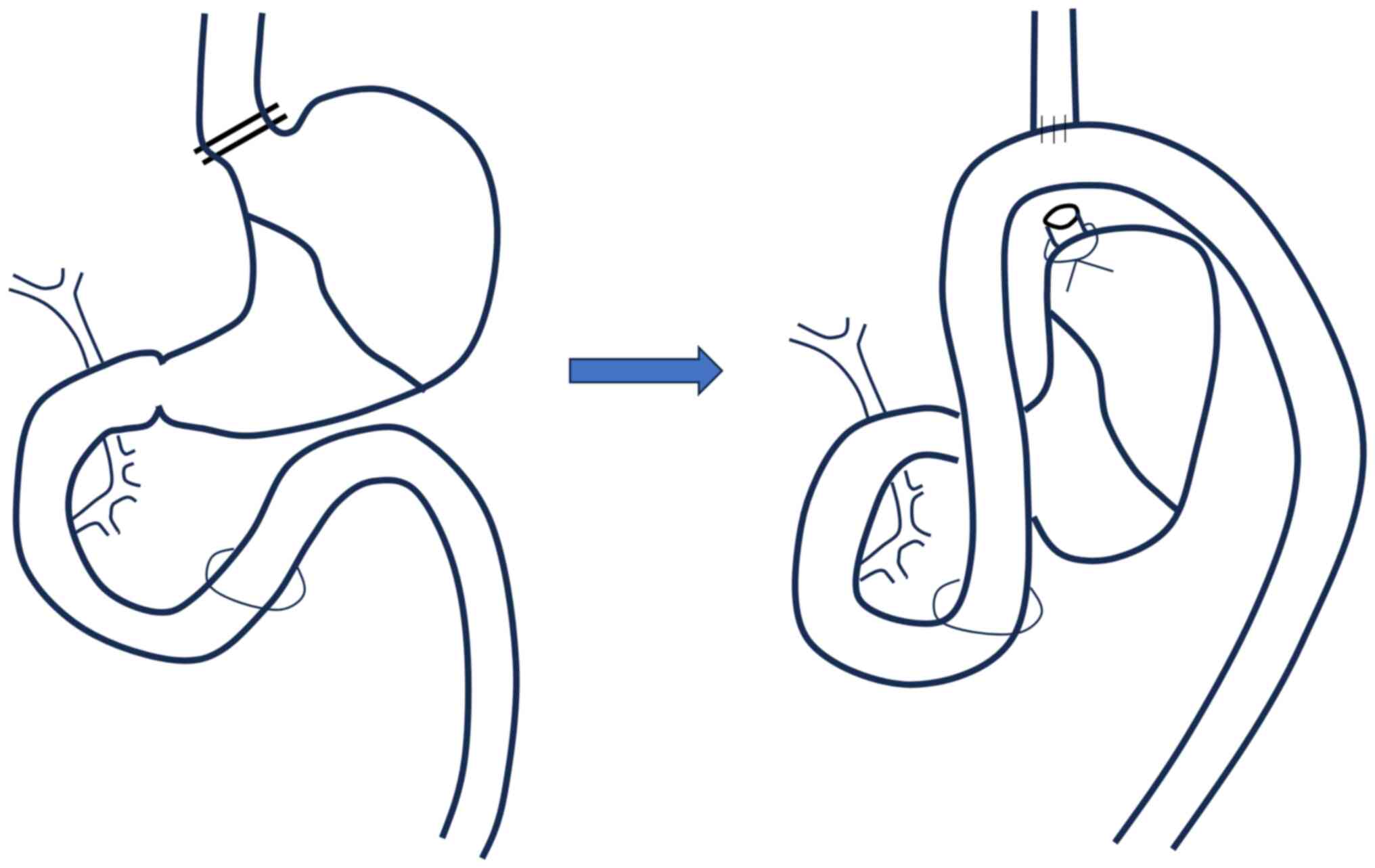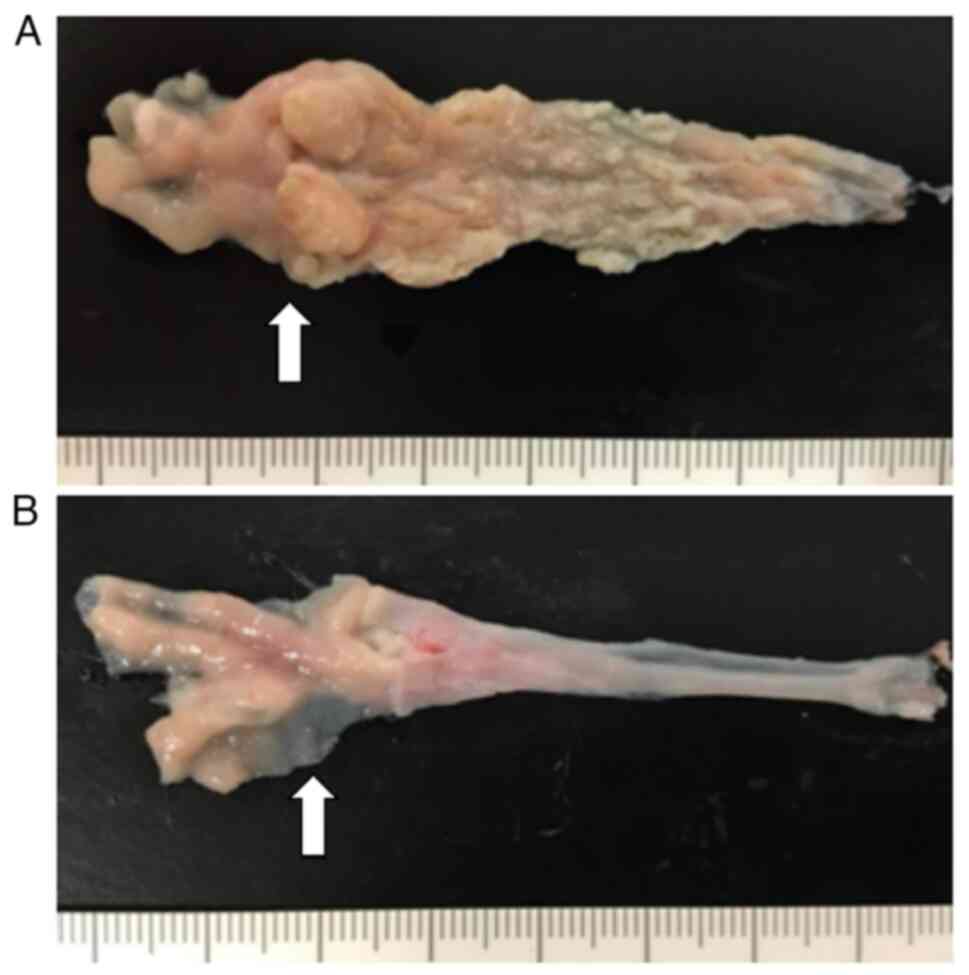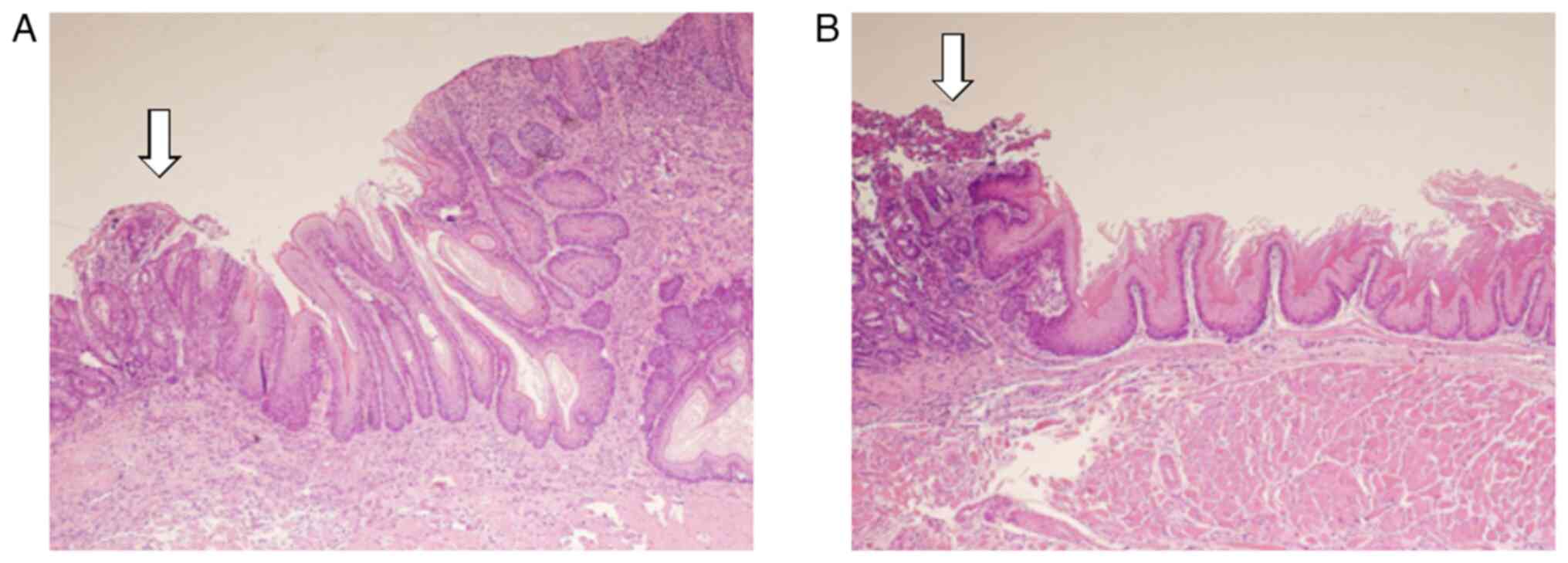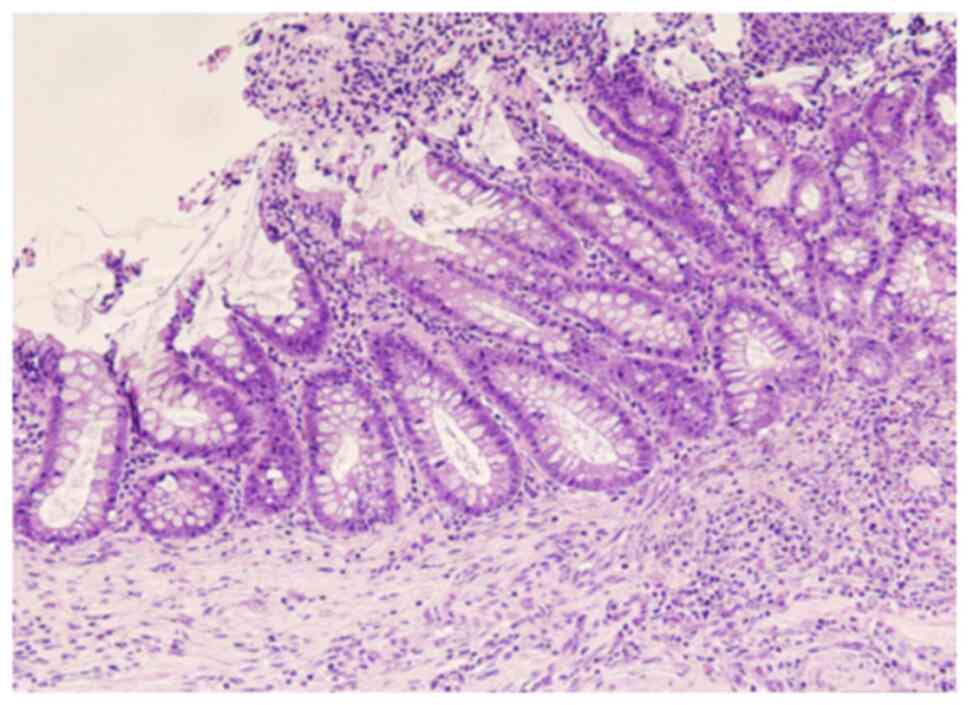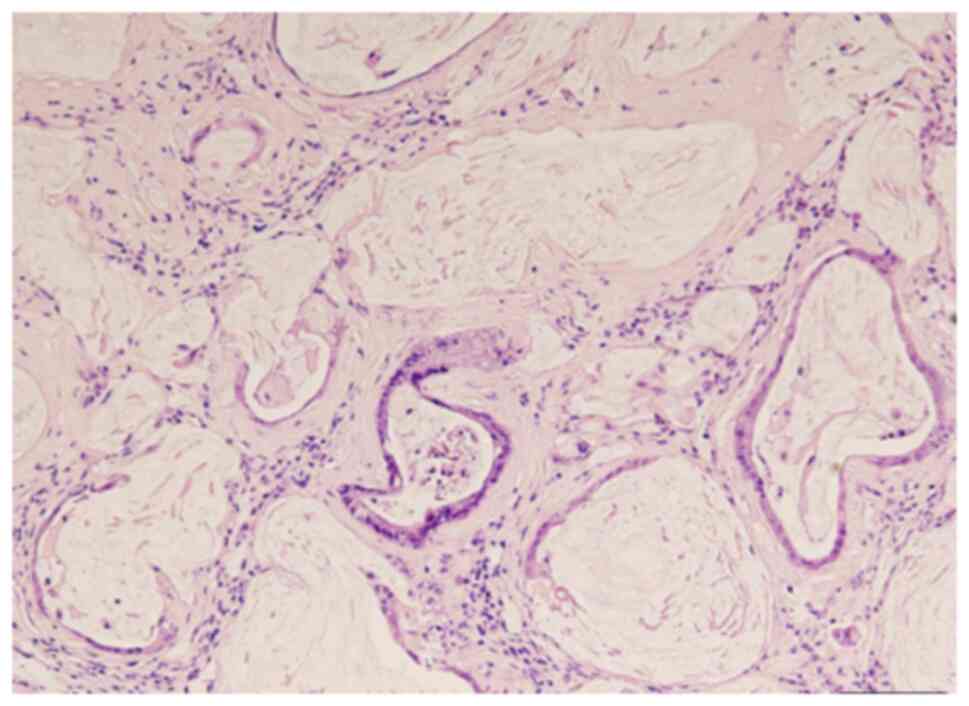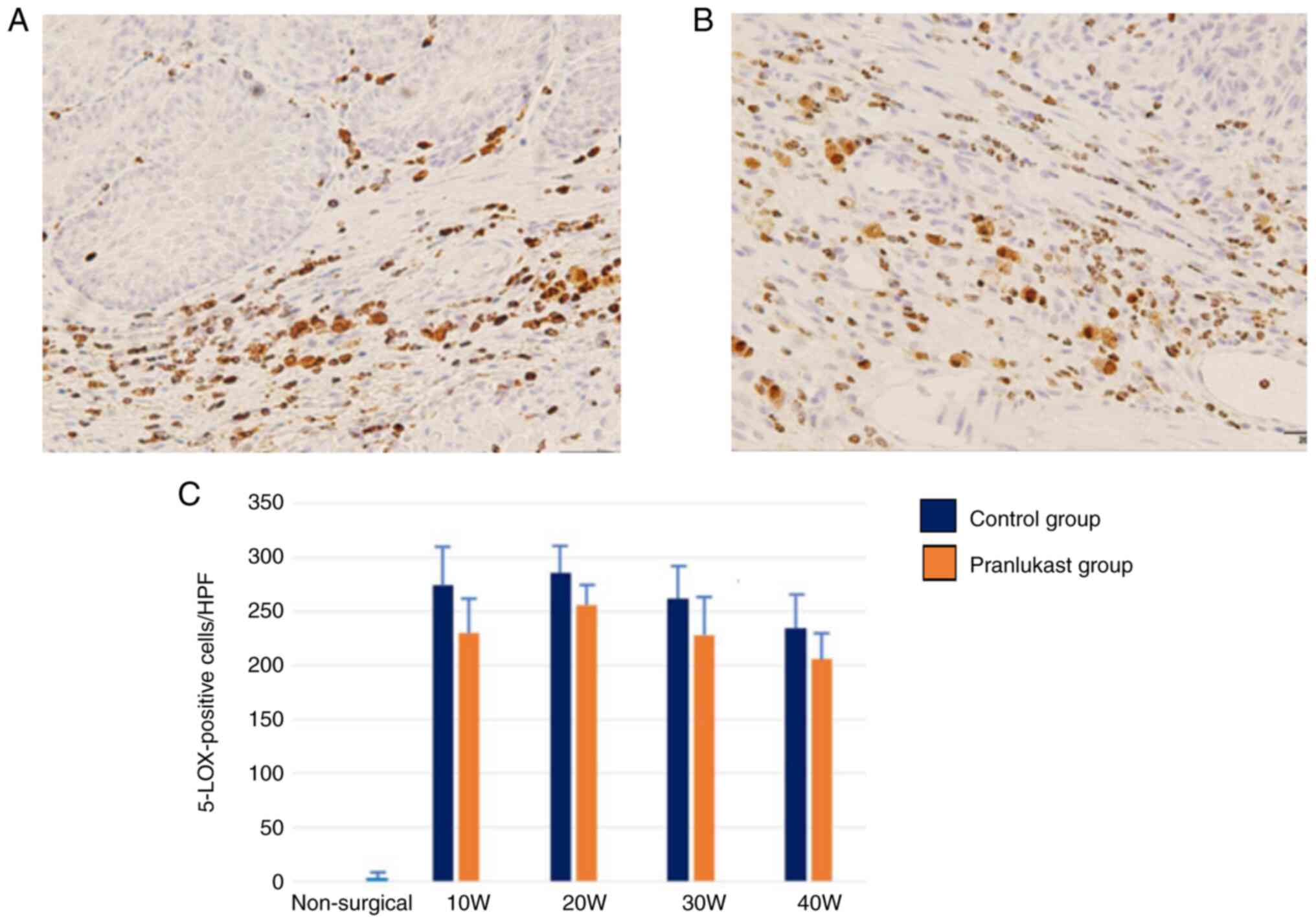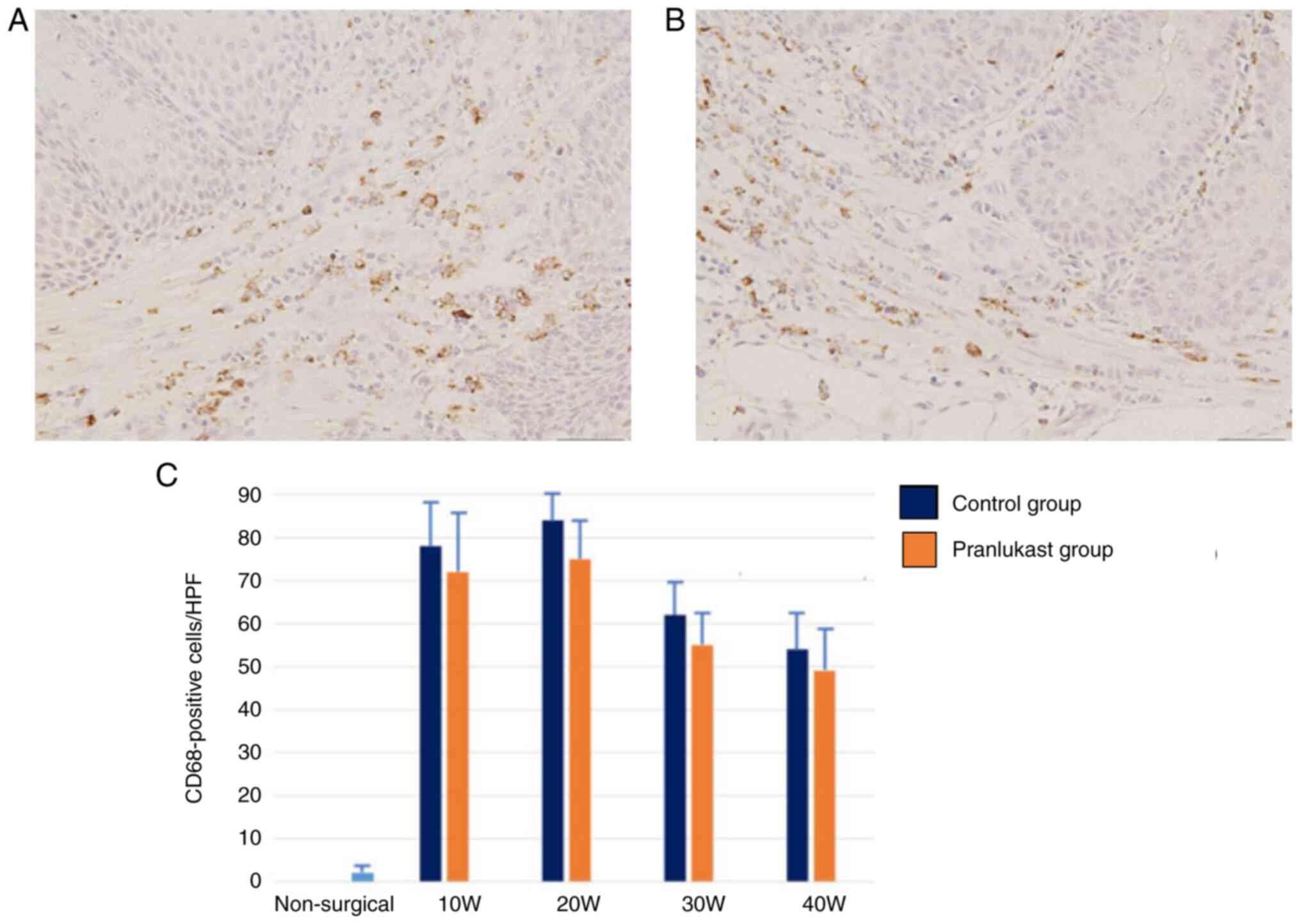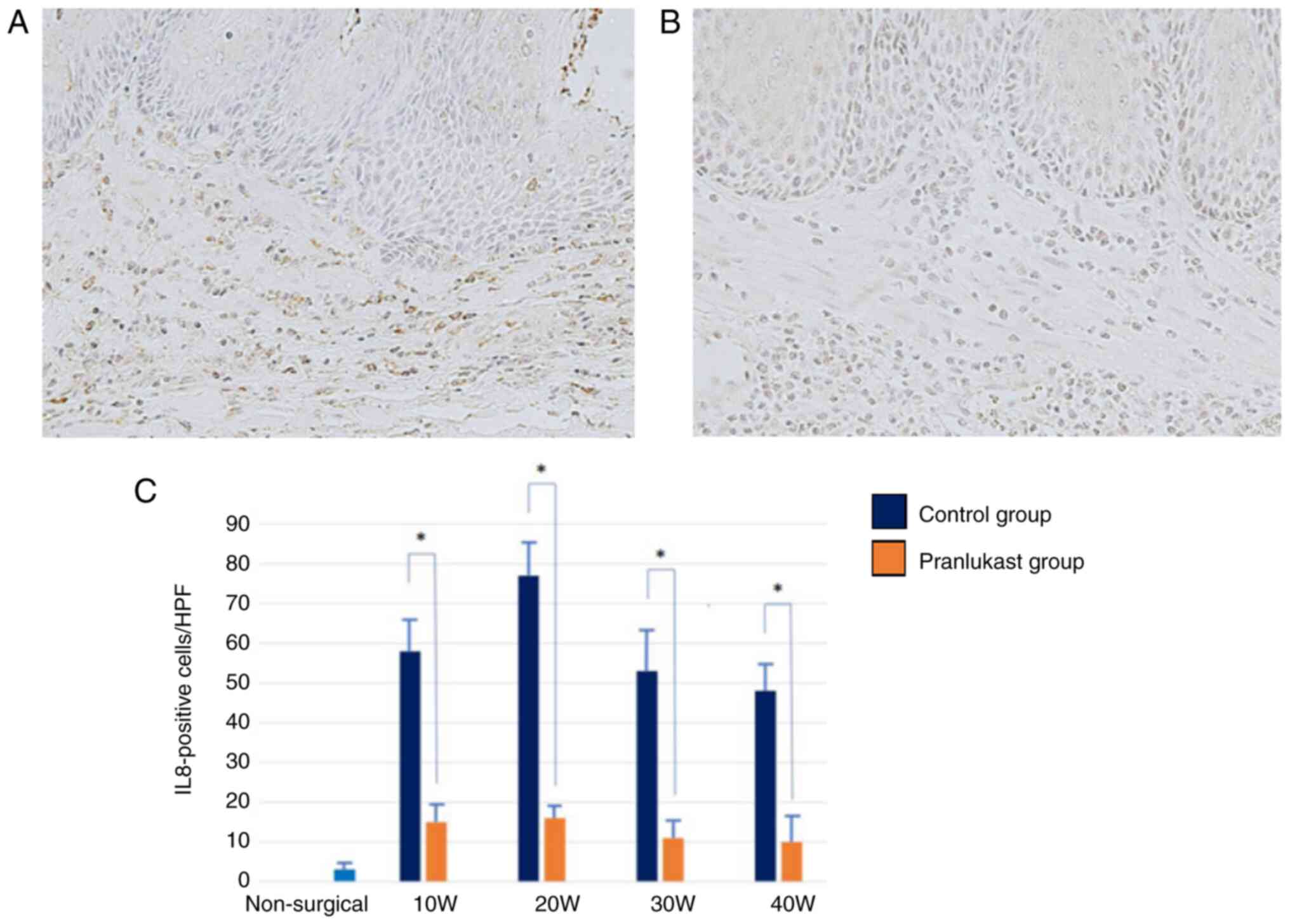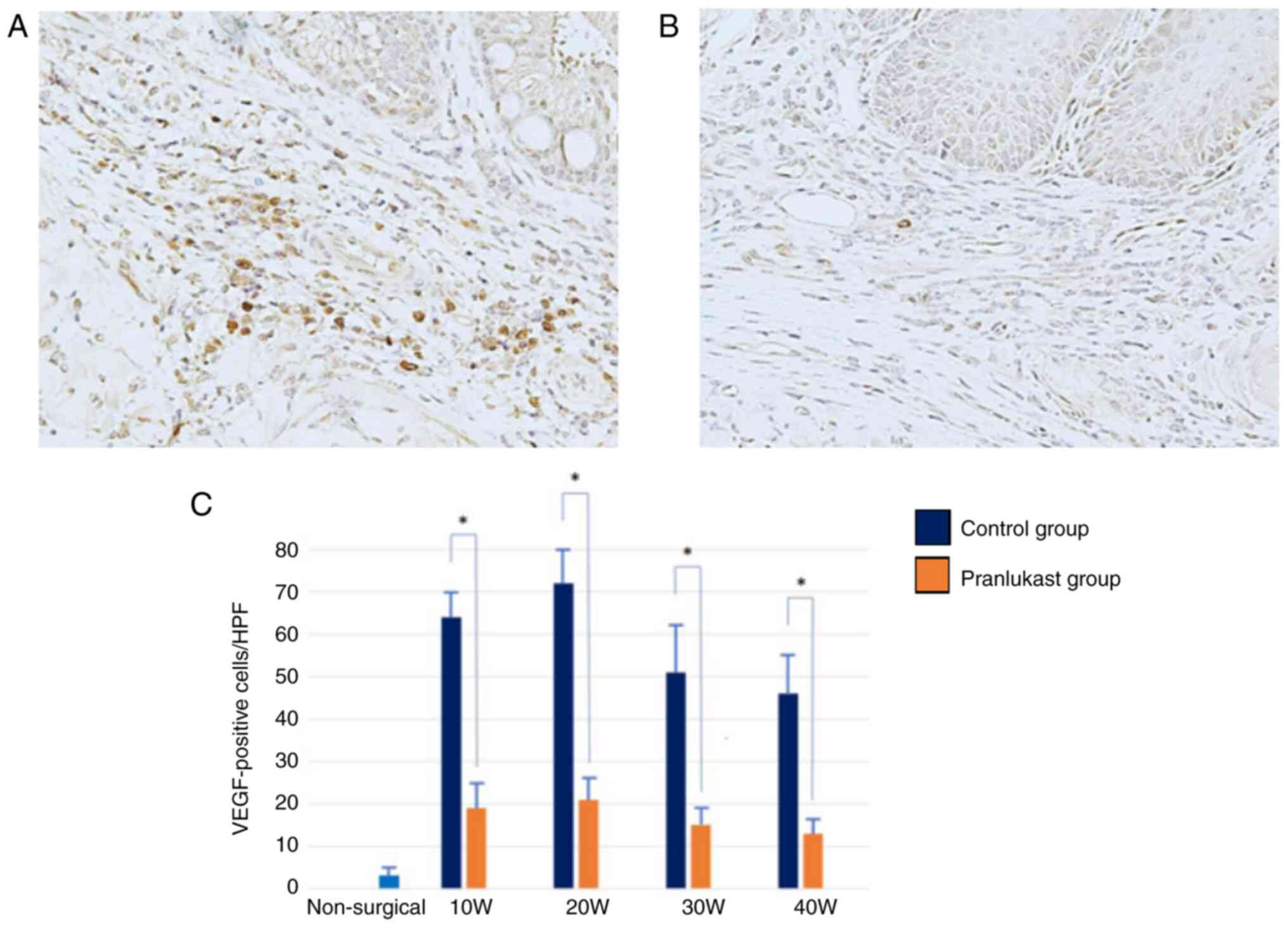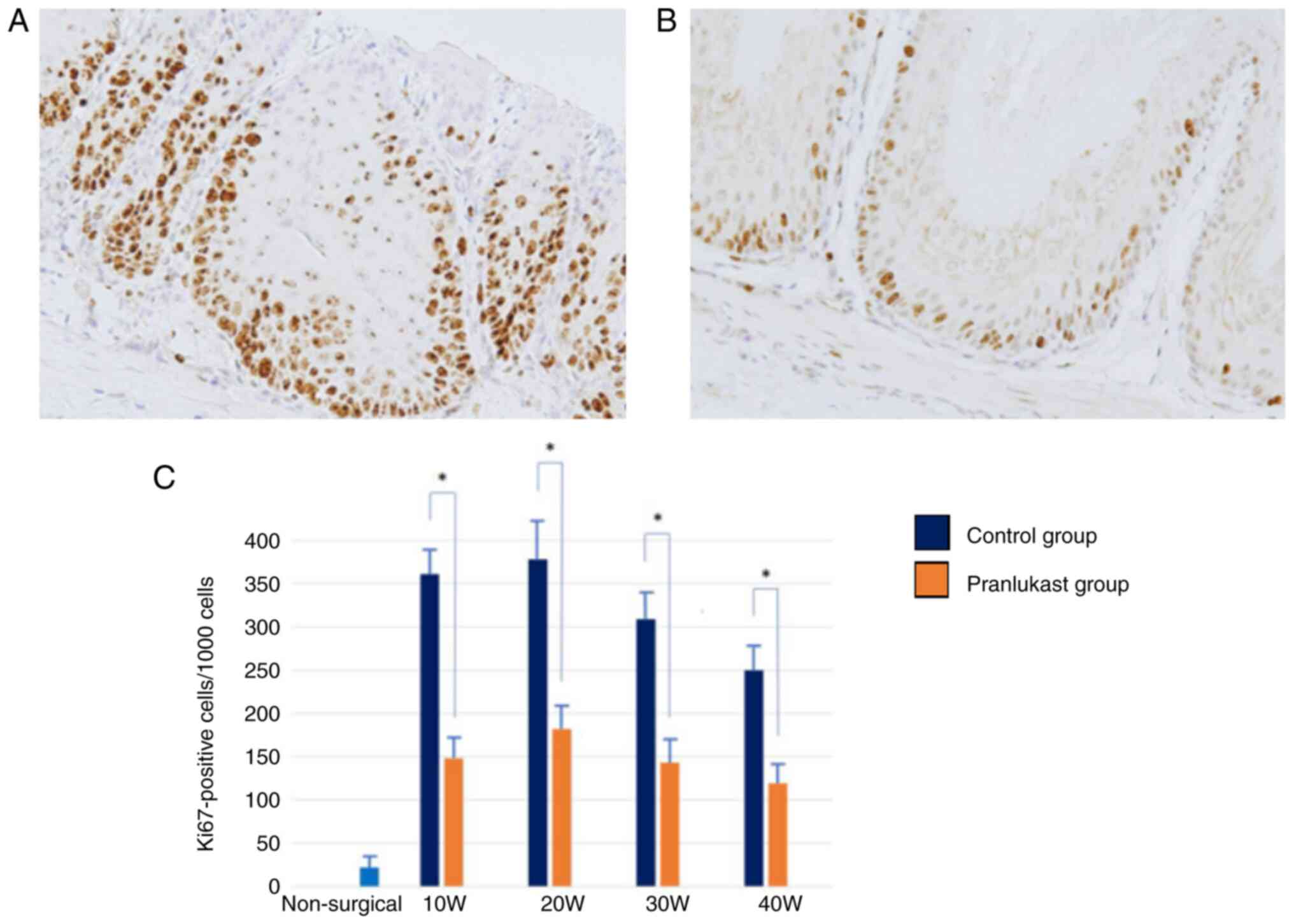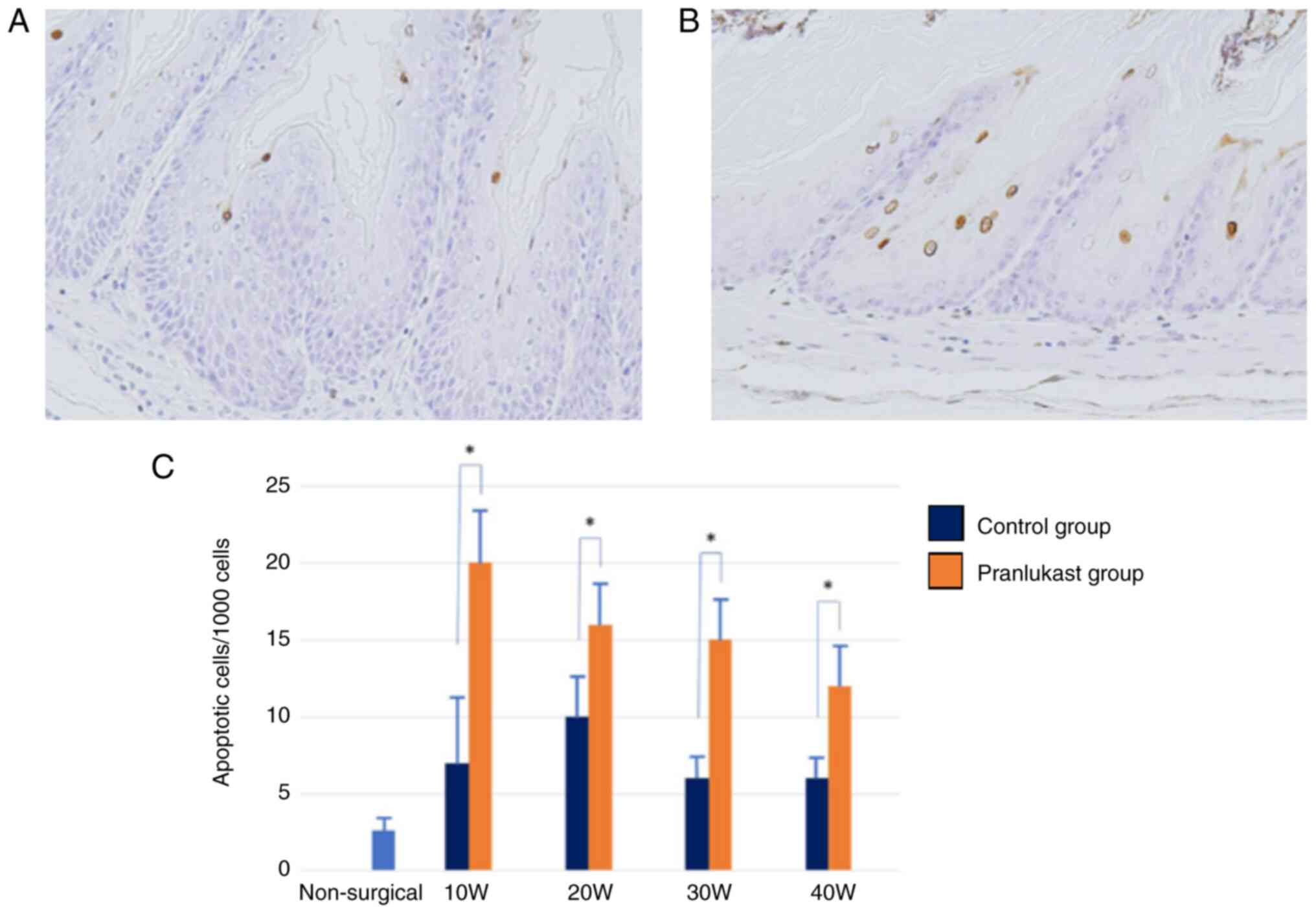|
1
|
Pera M: Epidemiology of esophageal cancer,
especially adenocarcinoma of the esophagus and esophagogastric
junction. Recent Results Cancer Res. 115:1–14. 2000. View Article : Google Scholar : PubMed/NCBI
|
|
2
|
Pohl H and Welch HG: The role of
overdiagnosis and reclassification in the marked increase of
esophageal adenocarcinoma incidence. J Natl Cancer Inst.
97:142–146. 2005. View Article : Google Scholar : PubMed/NCBI
|
|
3
|
Winters C Jr, Spurling TJ, Chobanian SJ,
Curtis DJ, Esposito RL, Hacker JF III, Johnson DA, Cruess DF,
Cotelingam JD, Gurney MS, et al: Barrett's esophagus. A prevalent,
occult complication of gastroesophageal reflux disease.
Gastroenterology. 92:118–124. 1987. View Article : Google Scholar : PubMed/NCBI
|
|
4
|
Reid BJ: Barrett's esophagus and
esophageal adenocarcinoma. Gastroenterol Clin North Am. 20:817–834.
1991. View Article : Google Scholar : PubMed/NCBI
|
|
5
|
Gillen P, Keeling P, Byrne PJ, Healy M,
O'Moore RR and Hennessy TP: Implication of duodenogastric reflux in
the pathogenesis of Barrett's oesophagus. Br J Surg. 75:540–543.
1988. View Article : Google Scholar : PubMed/NCBI
|
|
6
|
Falk GW: Barrett's esophagus.
Gastroenterology. 122:1569–1591. 2002. View Article : Google Scholar : PubMed/NCBI
|
|
7
|
Kauer WK, Peters JH, DeMeester TR, Ireland
AP, Bremner CG and Hagen JA: Mixed reflux of gastric and duodenal
juices is more harmful to the esophagus than gastric juice alone.
The need for surgical therapy re-emphasized. Ann Surg. 222:525–533.
1995. View Article : Google Scholar : PubMed/NCBI
|
|
8
|
Fujimura T, Oyama K, Sasaki S, Nishijima
K, Miyashita T, Ohta T, Miwa K and Hattori T: Inflammation-related
carcinogenesis and prevention in esophageal adenocarcinoma using
rat duodenoesophageal reflux models. Cancers (Basel). 3:3206–3224.
2011. View Article : Google Scholar : PubMed/NCBI
|
|
9
|
Jankowski JA, Harrison RF, Perry I,
Balkwill F and Tselepis C: Barrett's metaplasia. Lancet.
356:2079–2085. 2000. View Article : Google Scholar : PubMed/NCBI
|
|
10
|
Stein HJ, Feussner H, Kauer W, DeMeester
TR and Siewert JR: Alkaline gastroesophageal reflux: Assessment by
ambulatory esophageal aspiration and pH monitoring. Am J Surg.
167:163–168. 1994. View Article : Google Scholar : PubMed/NCBI
|
|
11
|
Iftikhar SY, Ledingham S, Steele RJ, Evans
DF, Lendrum K, Atkinson M and Hardcastleet JD: Bile reflux in
columnar-lined Barrett's oesophagus. Ann R Coll Surg Engl.
75:411–416. 1993.PubMed/NCBI
|
|
12
|
Lagergren J, Bergström R, Lindgren A and
Nyrén O: Symptomatic gastroesophageal reflux as a risk factor for
esophageal adenocarcinoma. N Engl J Med. 340:825–831. 1999.
View Article : Google Scholar : PubMed/NCBI
|
|
13
|
Miwa K, Segawa M, Takano Y, Matsumoto H,
Sahara H, Yagi M, Miyazaki I and Hattori T: Induction of
oesophageal and forestomach carcinomas in rats by reflux of
duodenal contents. Br J Cancer. 70:185–189. 1994. View Article : Google Scholar : PubMed/NCBI
|
|
14
|
Miwa K, Sahara H, Segawa M, Kinami S, Sato
T, Miyazaki I and Hattori T: Reflux of duodenal or gastro-duodenal
contents induces esophageal carcinoma in rats. Int J Cancer.
67:269–274. 1996. View Article : Google Scholar : PubMed/NCBI
|
|
15
|
Sato T, Miwa K, Sahara H, Segawa M and
Hattori T: The sequential model of Barrett's esophagus and
adenocarcinoma induced by duodeno-esophageal reflux without
exogenous carcinogens. Anticancer Res. 22:39–44. 2002.PubMed/NCBI
|
|
16
|
Goldstein SR, Yang GY, Curtis SK, Reuhl
KR, Liu BC, Mirvish SS, Newmark HL and Yanget CS: Development of
esophageal metaplasia and adenocarcinoma in a rat surgical model
without the use of a carcinogen. Carcinogenesis. 18:2265–2270.
1997. View Article : Google Scholar : PubMed/NCBI
|
|
17
|
Fein M, Peters JH, Chandrasoma P, Ireland
AP, Oberg S, Ritter MP, Bremner CG, Hagen JA and DeMeesteret TR:
Duodenoesophageal reflux induces esophageal adenocarcinoma without
exogenous carcinogen. J Gastrointest Surg. 2:260–268. 1998.
View Article : Google Scholar : PubMed/NCBI
|
|
18
|
Oyama K, Fujimura T, Ninomiya I, Miyashita
T, Kinami S, Fushida S, Ohta T and Miwa K: A COX-2 inhibitor
prevents the esophageal inflammation-metaplasia-adensocarcinoma
sequence in rats. Carcinogenesis. 26:565–570. 2005. View Article : Google Scholar : PubMed/NCBI
|
|
19
|
Peters-Golden M, Gleason MM and Togias A:
Cysteinyl leukotrienes: Multi-functional mediators in allergic
rhinitis. Clin Exp Allergy. 36:689–703. 2006. View Article : Google Scholar : PubMed/NCBI
|
|
20
|
Theron AJ, Steel HC, Tintinger GR, Gravett
CM, Anderson R and Feldman C: Cysteinyl leukotriene receptor-1
antagonists as modulators of innate immune cell function. J Immunol
Res. 2014:6089302014. View Article : Google Scholar : PubMed/NCBI
|
|
21
|
Byrum RS, Goulet JL, Snouwaert JN,
Griffiths RJ and Koller BH: Determination of the contribution of
cysteinyl leukotrienes and leukotriene B4 in acute inflammatory
responses using 5-lipoxygenase- and leukotriene A4
hydrolase-deficient mice. J Immunol. 163:6810–6819. 1999.
View Article : Google Scholar : PubMed/NCBI
|
|
22
|
Subramanian BC, Majumdar R and Parent CA:
The role of the LTB4-BLT1 axis in chemotactic gradient sensing and
directed leukocyte migration. Semin Immunol. 33:16–29. 2017.
View Article : Google Scholar : PubMed/NCBI
|
|
23
|
Tong WG, Ding XZ, Witt RC and Adrian TE:
Lipoxygenase inhibitors attenuate growth of human pancreatic cancer
xenografts and induce apoptosis through the mitochondrial pathway.
Mol Cancer Ther. 1:929–935. 2002.PubMed/NCBI
|
|
24
|
Wang D and Dubois RN: Eicosanoids and
cancer. Nat Rev Cancer. 10:181–193. 2010. View Article : Google Scholar : PubMed/NCBI
|
|
25
|
Ohd JF, Nielsen CK, Campbell J, Landberg
G, Löfberg H and Sjölander A: Expression of the leukotriene D4
receptor CysLT1, COX-2, and other cell survival factors in
colorectal adenocarcinomas. Gastroenterology. 124:57–70. 2003.
View Article : Google Scholar : PubMed/NCBI
|
|
26
|
Matsuyama M, Hayama T, Funao K, Kawahito
Y, Sano H, Takemoto Y, Nakatani T and Yoshimura R: Overexpression
of cysteinyl LT1 receptor in prostate cancer and CysLT1R antagonist
inhibits prostate cancer cell growth through apoptosis. Oncol Rep.
18:99–104. 2007.PubMed/NCBI
|
|
27
|
Moore GY and Pidgeon GP: Cross-talk
between cancer cells and the tumour microenvironment: The role of
the 5-lipoxygenase pathway. Int J Mol Sci. 18:2362017. View Article : Google Scholar : PubMed/NCBI
|
|
28
|
Boger PC, Shutt JD, Neale JR, Wilson SJ,
Bateman AC, Holloway JW, Patel P and Sampson AP: Increased
expression of the 5-lipoxygenase pathway and its cellular
localization in Barrett's adenocarcinoma. Histopathology.
61:509–517. 2012. View Article : Google Scholar : PubMed/NCBI
|
|
29
|
Shutt JD, Boger P, Neale JR, Patel P and
Sampson AP: Activity of the leukotriene pathway in Barrett's
metaplasia and oesophageal adenocarcinoma. Inflamm Res.
61:1379–1384. 2012. View Article : Google Scholar : PubMed/NCBI
|
|
30
|
Yang H, Jia X, Chen X, Yang CS and Li N:
Time-selective chemoprevention of vitamin E and selenium on
esophageal carcinogenesis in rats: The possible role of nuclear
factor kappaB signaling pathway. Int J Cancer. 131:1517–1527. 2012.
View Article : Google Scholar : PubMed/NCBI
|
|
31
|
Li N, Sood S, Wang S, Fang M, Wang P, Sun
Z, Yang CS and Chen X: Overexpression of 5-lipoxygenase and
cyclooxygenase 2 in hamster and human oral cancer and
chemopreventive effects of zileuton and celecoxib. Clin Cancer Res.
11:2089–2096. 2005. View Article : Google Scholar : PubMed/NCBI
|
|
32
|
Nozaki M, Yoshikawa M, Ishitani K,
Kobayashi H, Houkin K, Imai K, Ito Y and Muraki T: Cysteinyl
leukotriene receptor antagonists inhibit tumor metastasis by
inhibiting capillary permeability. Keio J Med. 59:10–18. 2010.
View Article : Google Scholar : PubMed/NCBI
|
|
33
|
Triadafilopoulos G, Kaczynska M and Iwane
M: Esophageal mucosal eicosanoids in gastroesophageal reflux
disease and Barrett's esophagus. Am J Gastroenterol. 91:65–74.
1996.PubMed/NCBI
|
|
34
|
Montford JR, Bauer C, Dobrinskikh E, Hopp
K, Levi M, Weiser-Evans M, Nemenoff R and Furgeson SB: Inhibition
of 5-lipoxygenase decreases renal fibrosis and progression of
chronic kidney disease. Am J Physiol Renal Physiol. 316:F732–F742.
2019. View Article : Google Scholar : PubMed/NCBI
|
|
35
|
Peters-Golden M and Henderson WR Jr:
Leukotrienes. N Engl J Med. 357:1841–1854. 2007. View Article : Google Scholar : PubMed/NCBI
|
|
36
|
Chen X, Li N, Wang S, Wu N, Hong J, Jiao
X, Krasna MJ, Beer DG and Yang CS: Leukotriene A4 hydrolase in rat
and human esophageal adenocarcinomas and inhibitory effects of
bestatin. J Natl Cancer Inst. 95:1053–1061. 2003. View Article : Google Scholar : PubMed/NCBI
|
|
37
|
Arango Duque G and Descoteaux A:
Macrophage cytokines: Involvement in immunity and infectious
diseases. Front Immunol. 5:4912014. View Article : Google Scholar : PubMed/NCBI
|
|
38
|
Maruyama K, Kidoya H, Takemura N, Sugisawa
E, Takeuchi O, Kondo T, Eid MMA, Tanaka H, Martino MM, Takakura N,
et al: Zinc finger protein St18 protects against septic death by
inhibiting VEGF-A from macrophages. Cell Rep. 32:1079062020.
View Article : Google Scholar : PubMed/NCBI
|
|
39
|
Fitzgerald RC, Onwuegbusi BA,
Bajaj-Elliott M, Saeed IT, Burnham WR and Farthing MJG: Diversity
in the oesophageal phenotypic response to gastro-oesophageal
reflux: Immunological determinants. Gut. 50:451–459. 2002.
View Article : Google Scholar : PubMed/NCBI
|
|
40
|
Nguyen GH, Schetter AJ, Chou DB, Bowman
ED, Zhao R, Hawkes JE, Mathé EA, Kumamoto K, Zhao Y, Budhu A, et
al: Inflammatory and microRNA gene expression as prognostic
classifier of Barrett's-associated esophageal adenocarcinoma. Clin
Cancer Res. 16:5824–5834. 2010. View Article : Google Scholar : PubMed/NCBI
|
|
41
|
Shrivastava MS, Hussain Z, Giricz O,
Shenoy N, Polineni R, Maitra A and Verma A: Targeting chemokine
pathways in esophageal adenocarcinoma. Cell Cycle. 13:3320–3327.
2014. View Article : Google Scholar : PubMed/NCBI
|
|
42
|
Möbius C, Stein HJ, Becker I, Feith M,
Theisen J, Gais P, Jütting U and Siewert JR: The ‘angiogenic
switch’ in the progression from Barrett's metaplasia to esophageal
adenocarcinoma. Eur J Surg Oncol. 29:890–894. 2003. View Article : Google Scholar : PubMed/NCBI
|
|
43
|
Haneda Y, Hasegawa S, Hirano R, Hashimoto
K, Ohsaki A and Ichiyama T: Leukotriene D4 enhances tumor necrosis
factor-α-induced vascular endothelial growth factor production in
human monocytes/macrophages. Cytokine. 55:24–28. 2011. View Article : Google Scholar : PubMed/NCBI
|
|
44
|
Tsai MJ, Wu PH, Sheu CC, Hsu YL, Chang WA,
Hung JY, Yang CJ, Yang YH, Kuo PL and Huang MS: Cysteinyl
leukotriene receptor antagonists decrease cancer risk in asthma
patients. Sci Rep. 6:239792016. View Article : Google Scholar : PubMed/NCBI
|
|
45
|
Sutton SS, Magagnoli J, Cummings TH and
Hardin JW: Leukotriene inhibition and the risk of lung cancer among
U.S. veterans with asthma. Pulm Pharmacol Ther. 71:1020842021.
View Article : Google Scholar : PubMed/NCBI
|
|
46
|
Hormi-Carver K, Feagins L, Spechler S and
Souza R: All trans-retinoic acid induces apoptosis via p38 and
caspase pathways in metaplastic Barrett's cells. Am J Physiol
Gastrointest Liver Physiol. 292:G18–G27. 2007. View Article : Google Scholar : PubMed/NCBI
|
|
47
|
Kachi K, Kato H, Naiki-Ito A, Komura M,
Nagano-Matsuo A, Naitoh I, Hayashi K, Kataoka H, Inaguma S and
Takahashi S: Anti-allergic drug suppressed pancreatic
carcinogenesis via down-regulation of cellular proliferation. Int J
Mol Sci. 22:74442021. View Article : Google Scholar : PubMed/NCBI
|
|
48
|
Magnusson C, Liu J, Ehrnström R, Manjer J,
Jirström K, Andersson T and Sjölander A: Cysteinyl leukotriene
receptor expression pattern affects migration of breast cancer
cells and survival of breast cancer patients. Int J Cancer.
129:9–22. 2011. View Article : Google Scholar : PubMed/NCBI
|
|
49
|
Bellamkonda K, Chandrashekar NK, Osman J,
Selvanesan BC, Savari S and Sjölander A: The eicosanoids
leukotriene D4 and prostaglandin E2 promote the tumorigenicity of
colon cancer-initiating cells in a xenograft mouse model. BMC
Cancer. 16:4252016. View Article : Google Scholar : PubMed/NCBI
|



